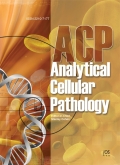Authors: Hipp, Jason | Monaco, James | Kunju, L. Priya | Cheng, Jerome | Yagi, Yukako | Rodriguez-Canales, Jaime | Emmert-Buck, Michael R. | Hewitt, Stephen | Feldman, Michael D. | Tomaszewski, John E. | Toner, Mehmet | Tompkins, Ronald G. | Flotte, Thomas | Lucas, David | Gilbertson, John R. | Madabhushi, Anant | Balis, Ulysses
Article Type:
Research Article
Abstract:
Introduction: The advent of digital slides offers new opportunities within the practice of pathology such as the use of image analysis techniques to facilitate computer aided diagnosis (CAD) solutions. Use of CAD holds promise to enable new levels of decision support and allow for additional layers of quality assurance and consistency in rendered diagnoses. However, the development and testing of prostate cancer CAD solutions requires a ground truth map of the cancer to enable the generation of receiver operator characteristic (ROC) curves. This requires a pathologist to annotate, or paint, each of the malignant glands in prostate cancer with an
…image editor software - a time consuming and exhaustive process. Recently, two CAD algorithms have been described: probabilistic pairwise Markov models (PPMM) and spatially-invariant vector quantization (SIVQ). Briefly, SIVQ operates as a highly sensitive and specific pattern matching algorithm, making it optimal for the identification of any epithelial morphology, whereas PPMM operates as a highly sensitive detector of malignant perturbations in glandular lumenal architecture. Methods: By recapitulating algorithmically how a pathologist reviews prostate tissue sections, we created an algorithmic cascade of PPMM and SIVQ algorithms as previously described by Doyle el al. [1] where PPMM identifies the glands with abnormal lumenal architecture, and this area is then screened by SIVQ to identify the epithelium. Results: The performance of this algorithm cascade was assessed qualitatively (with the use of heatmaps) and quantitatively (with the use of ROC curves) and demonstrates greater performance in the identification of malignant prostatic epithelium. Conclusion: This ability to semi-autonomously paint nearly all the malignant epithelium of prostate cancer has immediate applications to future prostate cancer CAD development as a validated ground truth generator. In addition, such an approach has potential applications as a pre-screening/quality assurance tool.
Show more
Keywords: Pathology informatics, whole slide imaging, computer aided diagnosis, SIVQ, PPMM, digital imaging, prostate cancer, cancer
DOI: 10.3233/ACP-2012-0054
Citation: Analytical Cellular Pathology,
vol. 35, no. 4, pp. 251-265, 2012
Price: EUR 27.50





